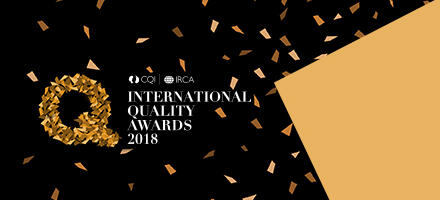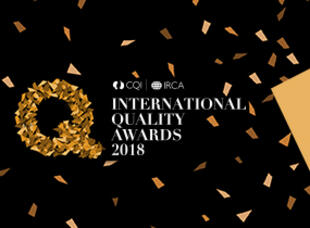
Assuring the future of the assurance market
Progress indicator
John Rowley, Global CEO at SAI Global Assurance, headline partner of the 2018 International Quality Awards, talks to Tracy Tyley about his role, company goals, and the key challenges affecting the industry.
1. You joined SAI Global Assurance in Sydney in February 2018 after previously working as Global Managing Director at the Lloyd’s Register Quality Assurance (LRQA) and Inspection Services businesses. Tell me about your new role.
My role as Global CEO is straightforward and I look at it as threefold: firstly, to set a strategy and plan for the business to deliver a valued portfolio of services to the client base; secondly, to put a leadership team and structure in place to deliver that strategy; and thirdly, to drive, coach and monitor that team to deliver that strategy. In addition, we are wholly owned by Barings Private Equity so I need to have a lot of interaction with them, to ensure they know their investment is moving forward to plan. They are very supportive but have high expectations, as they should have, rather like a good parent.
2. What are your current plans for SAI Global Assurance?
I have recently reset the SAI Global assurance strategy. In its purest form, strategy is about choices – of which geographies, sectors and services the business is going to focus on, and then ensuring those choices are appropriately resourced and funded. It’s then about executing with urgency and passion. We will focus our business on our key markets, whilst ensuring we are able to seamlessly service global clients. We will also focus on our core sectors, such as food and its supply chain, ensuring we work to a market-led approach and deliver services our clients truly value. Ultimately, I want us to be known as experts in understanding and balancing the risk versus performance equation for our clients, and to be a company that our clients find refreshing to work with.
3. What is the focus of the new strategy?
Like any company, we are ultimately measured on revenue and profit growth compared to the market, and ensuring we make the business better today than it was yesterday. I want to achieve that by being a company led by market needs and enabled by technology. A company whom our clients enjoy working with, and whom our employees enjoy working for. To effectively deliver this we must ensure we put in place the best possible team, structured in the optimal way to deliver maximum value to our clients with passion, urgency and focus. Our goals are centred around these core principals, as they will lead to satisfied clients, engaged employees and financial success.
4. In your opinion, what are the challenges facing the quality sector today?
The quality sector has many challenges. In my view these are centred around generating benefit realisation from certification, impactful and value-added reporting, technology and disruption, data management and ownership, and an ageing auditor workforce. The 2015 transition to new standards is a good example of either the industry struggling to prove its value to the client base, or the client base struggling to capture that value. The fact that, with ISO 9001, less than 50% of certificates have been transitioned after 80% of the time has elapsed (as at end February 2018) is testament to that, and the industry needs to continue to push the addressable value of transition or we will see a drop in the number of global certificates beginning to materialise after September, which would be a travesty.
5. What challenges do you think auditors are facing?
Auditors are absolutely central to the quality industry, and the value of certification needs to be driven through them. They are facing challenges of increasing complexity of standards, the plateauing of the quality management system, demonstrating value beyond certification, rapid technology shifts and the sheer variety of the types of clients and manufacturing plants they audit and assess. Auditors need to continue to raise their (already high) standards and for that they need to be closely associated with certification bodies. The potential ‘uberisation’ disruption of our industry, of treating auditors as commodities for hire, goes against the pursuit of quality and risk optimisation.
6. Globalisation, digitisation and advances in technology have dramatically changed the way companies operate as well as the sheer velocity and number of risks faced. How can organisations adapt to the changes and reduce such risks?
Firstly, change is inevitable, so let’s be clear that the industry needs to work with it not against it. Companies need to understand where they fit, or want to fit, on the risk versus performance equation. They need to work with expert knowledgeable partners to understand how globalisation, digitalisation and technology advancement can help not hinder their own strategic progress. More and more use of available software tools is helping to enable this process, and will continue to do so.
7. There are many approaches to mitigating risks. What advice or tools do you recommend to organisations looking to simplify such processes?
Process simplification is often sought but rarely optimally accomplished. I think the holy grail of risk mitigation is the ability to predict when and where it is, and when and where it will materialise into a problem. There are many tools to collate risk-rich information, collate it for clients and use it for benchmarking against their own competitive set or industry norms. However, these tools don’t tend to give expert insight into how to translate this data into valuable information to manage risks going forward. And they certainly don’t accurately predict where risks will occur in the future, so they can be appropriately headed off before they occur. We are currently developing an industry’s unique predictive analytics tool, which initial trials indicate can predict risk with 95% accuracy, such that mitigating actions can be deployed in advance. I believe such tools could be a game changer in enabling clients to manage risk more efficiently and effectively.
8. How can quality managers help improve business assurance?
Quality managers in some ways face similar challenges to auditors, in keeping up with the sheer pace of technology and supply chain complexity, and both need to work together in partnership. They need to seek simplicity, ensure process is always king, seek continuous personal development and not be afraid to ask for help and advice from trusted partners, especially in understanding which tools to deploy to which scenarios. Don’t forget consumers are becoming more and more well informed about the products they procure (what they contain, how they are made, where they come from, etc), and their expectations are becoming more refined. The consumer is the ultimate arbitrator of quality, and social media can soon turn quality lapses into a major brand catastrophe. As such, I think in the future quality managers will become an even more critical resource in organisations, not less.
"In an increasingly litigious world, a good reputation is hard to build and easy to lose."
9. How can businesses ensure supply chain assurance?
It is impossible to categorically ensure supply chain assurance, but a sensible approach can certainly help mitigate the risk and gain an acceptable level of comfort for the business as well as its consumers and clients, and thus help protect the business’ brand. In an increasingly litigious world, a good reputation is hard to build and easy to lose. The challenge to supply chain assurance is to pursue it at an acceptable cost and with minimal disruption to the business and its suppliers, which requires considerable knowledge of the supply chain, its weak points and its strong points. Establishment of a comprehensively managed second and/or third-party audit programme from a reputable provider, backed up by sensible use of the correct technology and software tools, will go a long way to managing the risk posed by supply chains.
10. Why is an ‘integrated’ approach to managing risk and compliance so important?
An integrated approach to managing risk will become more and more important as a key way of counter-balancing advances in technology, increases in manufacturing and supply chain complexity, and to staying in control of the risk versus performance equation. A successful integrated approach needs to reduce complexity, not increase it.
11. What can organisations do to remain competitive?
There are many factors but three stand out for me: ensuring you are both current and relevant, providing addressable value and being bigger than your products. Being both current and relevant is about remaining ahead of technology progression and lifestyle evolution, such that your products stand out and are highly sought after. Providing addressable value is about delivering superior value versus the competition, which is obvious, but more importantly it’s about ensuring your clients can see and capture that value. Ensuring you are bigger than your products will continue to increase in importance, and is about proving to your client base that you are a staunch corporate citizen, with a purpose, that truly cares about the wider needs of society and the environment. Each of these factors on their own is reasonably straightforward to address, but together they represent quite a challenge.
12. What is the most interesting thing you have learnt in your career so far?
I think the most important thing I continue to learn every day is to never think you can stop learning, and I believe there is something good you can learn from everyone in your organisation and network. This is the only way to evolve as an industry expert and as a leader, and the more you seek improvement the more you will evolve. Related to this, if you reach the point where you are no longer learning or evolving in your job, move on.

John Rowley, Global CEO at SAI Global Assurance

